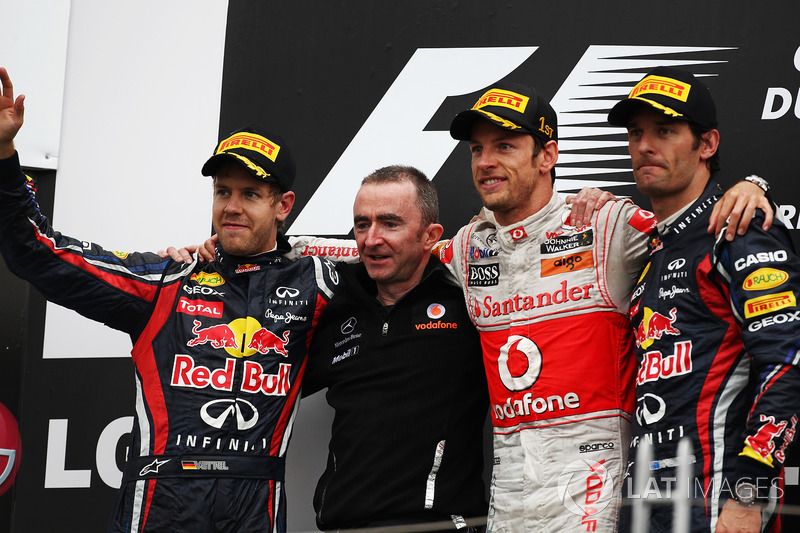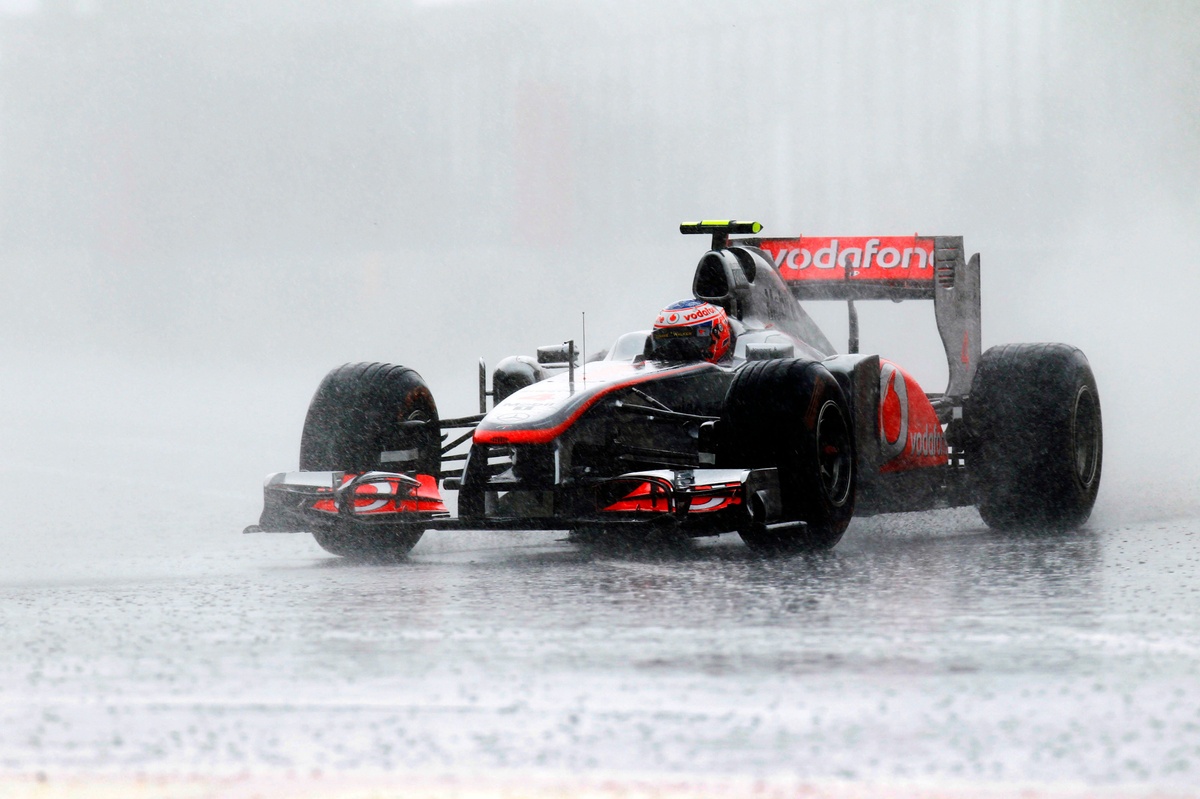Four hours, four minutes, 37 seconds. The Canadian Grand Prix of 2011 is famed for two things: one, being Formula 1’s longest-ever race (a record that will likely never be beaten), and two, Jenson Button’s unlikely victory after falling to the back of the field.
It’s considered as one of Button’s best races, one in which he battled against the elements (and more than a few tangles) to work his way from the back of the field to the front. Button was always renowned for his performances in changeable conditions, a skill developed in his karting days when he was usually forced to race in similar conditions with slick tyres. Equipped with a high-downforce set-up as McLaren anticipated a washout Sunday, it was a race very much in Button’s wheelhouse.
That said, he’d been in the wars somewhat throughout the first half. The race had begun behind the safety car for the opening four laps; he then sustained his first measure of contact with McLaren team-mate Lewis Hamilton after just three laps of green-flag running. Hamilton had qualified two positions up on Button – starting fifth, versus Button’s seventh – but lost ground when he made contact with Mark Webber at Turn 2 amid the subsequent evasive action.
What followed was a series of passes decided by slips off-course: Button then went wide in Turn 6 to let Michael Schumacher trickle through into fifth, and Hamilton got back past as Button tried to gather up his wayward machinery. On the following tour, lap six, Hamilton then attempted to put a move on Schumacher at the hairpin – but the seven-time champion held the future seven-timer off-line to allow Button passage back into sixth.
At the end of the seventh tour, the McLarens made contact. While attempting to recover those lost positions, Hamilton tried to stuff his car down the left-hand side of Button on the start-finish straight, although Button was closing the door. This was faithfully reproduced some 14 years later when Oscar Piastri and Lando Norris reenacted a similar incident – again, the driver attempting to make the overtake came much worse off.
Button admitted that hadn’t seen Hamilton coming, who suffered damage to his left-rear wheel and had to peel off at Turn 7 to herald the return of the safety car. Button used this as a chance to pit, ditching his full-wet tyres for the intermediate compound to emerge in 12th, but was then pinged for speeding behind the safety car. This prompted a drive-through penalty as Bernd Maylander’s Mercedes came in, which Button served immediately to drop down to 15th.

Hamilton tried to pass Button at the end of the seventh lap – but it was in vain
Photo by: Andy Hone / Motorsport Images
Finally given the chance to give his inters a workout, Button made swift progress through the wet-shod midfielders, while lapping considerably quicker than race-leader Sebastian Vettel. Once on the back of Paul di Resta’s Force India and the two Renaults, progress slowed down, but di Resta was eventually dispatched to bring Button up to eighth.
As soon as Button had cleared Vitaly Petrov for seventh, the rain had swiftly intensified. The dry line on-track had been eradicated in a few short seconds, as had the advantage of the intermediates. Visibility had also got increasingly tricky, and a wall of pallid spray veiled the back straight. The safety car returned again in anticipation of the conditions worsening.
In response, Button switched back to the wets, the conditions now beyond the reach of the intermediates. Rain had continued to engulf the Ile Notre-Dame and, after 24 laps, the race was subsequently red-flagged. It remained on hiatus for another two hours, as the cars collected the downpour while waiting on the grid.
After an agonising wait, and after a few laps behind the safety car, Button dispatched Pedro de la Rosa (standing in for an injured Sergio Perez) on the restart, then pitted for inters. This put him onto Fernando Alonso’s tail, after the Ferrari driver was delayed during his own stop as his team had to double-stack. It prompted a clash between the two at Turn 3; Alonso was left beached on the kerb, and the safety car returned to the circuit after a mere two laps of green-flag running. This was the moment that put Button into 21st – last place – as he limped to the pit lane with a puncture and a broken front wing.
“But I loved it,” Button wrote in his autobiography Life to the Limit. “I got my head down and began my charge, driving as smoothly and as fast as I ever have, and beginning to make my way back up the field […] playing my McLaren like it was a kart and I was a kid again.”
And so, the recovery began on the lap 41 restart. The HRT cars offered no resistance on the restart, and nor did the Virgins and the sole remaining Lotus of Jarno Trulli. Within 10 laps, Button had roared back into the top 10, but chose to sacrifice his position once more when he took a punt on slick tyres at the end of lap 51. By now, a prominent dry line had broken through the wet track surface, and the supersoft Pirellis were very much the tyres to be on. With an undercut in the offing, Button had given up eighth place and traded it for seventh.
The seas continued to part. Felipe Massa aquaplaned while lapping an HRT and knocked off his front wing. Kamui Kobayashi and Petrov pitted a lap too late and were easy pickings for Button, who also put a move on Nick Heidfeld to grab fourth. There was a seven-second void to fill before Button could reach the battle for second between Michael Schumacher and Mark Webber, who in turn were 10 seconds behind long-time leader Sebastian Vettel.
When Heidfeld then went into the back of Kobayashi, as the Sauber driver got a glacial getaway out of Turn 2 compared to the Renault, it shed front-wing debris all over the circuit. The safety car was pulled into action again, just for four laps this time, to bring the top four into play.

Button made six trips to the pitlane – one for a drive-through after speeding behind the safety car
Photo by: Rainer W. Schlegelmilch / Motorsport Images
Button had a lapped Timo Glock sitting in front of him, in the days before lapped runners were waved around by the race director, which appeared to release the top three ahead of the final 10-lap showdown.
Once Glock was cleared, Button was quickly on the tail of Webber, who was attempting to throw a move down the inside of Schumacher. When Webber cut the chicane at the end of lap 64 and had to check up, Button pounced and made up a further place, and then wrested second from Schumacher with DRS on the next tour. There were just five laps to go, and a 3.1s deficit to Vettel to close down.
Vettel was driving cautiously. He’d been strong in the wet conditions and had built himself comfortable buffer over the preceding 60 laps. But the late safety car had scythed that buffer away, and the still-perilous track surface did not exactly mesh with his lower-downforce set-up. Thus, Button halved that deficit in one lap, and continued to ladle on the pressure, forcing Vettel to pick up the pace for the first time that afternoon.
Famously, it all came down to the final lap. Button was within DRS range and closed up to the back of Vettel – yet it was the reigning champion who did the work for him. A slide at Turn 6 put the Red Bull off-course, gifting Button the lead and a monumental victory. He’d come from the back to the front in just 30 laps, having forced the reigning champion into a last-gasp mistake.
Versus Button’s other rain-affected wins, his first F1 victory in 2006’s Hungarian Grand Prix, his 2009 half-distance win in Malaysia’s torrential conditions, and his 2010 drive in Australia, his race in Montreal was surely his most special. When you consider his career as a whole, it feels like the quintessential Button win.

Button secured the first of three wins in 2011, helping his charge to second in the championship
Photo by: Sutton Images
How Canada 2011 changed wet races forever
Following the two-hour red flag period, the Montreal race had exposed a flaw in the rules: there was no maximum allotted time for a race beyond the two-hour limit for green-flag running. As such, a four-hour limit was installed to ensure races were not likely to be constrained by sunset. The limit was subsequently reduced to three hours in 2021.
While F1’s race directors had usually only ever opted to throw red flags in response to an accident, Canada’s was called in response to the weather itself. At the time, drivers had been keen for race control to take a more proactive stance to stopping races if the conditions were particularly abject, rather than continue on and risk injury.
Red flags in anticipation of poor weather has been much more accepted of late. Although F1 fans like to joke that Pirelli’s wet tyre compound is almost useless, as its appearance is usually preceded by a pause in running, the main issue today in wet races is actually visibility, not circuit grip.
In recent years, F1 and the FIA have attempted to curb this and have tested wheelguards to mitigate spray, which has been worsened by the current aerodynamic packages. It remains to be seen whether 2026’s regulations will naturally handle some of that, particularly as the tyres and bodywork are narrower for next year, but there should be a small improvement nonetheless.
While people tend to decry the caution in wet races today, it’s much more palatable that the race director feels more empowered to pre-empt situations in poor weather, rather than let disaster strike.

Rain delays are much more commonplace today – 2022’s Monaco GP started late as heavy rain was on the horizon
Photo by: Erik Junius
Read Also:
We want to hear from you!
Let us know what you would like to see from us in the future.
– The Autosport.com Team

